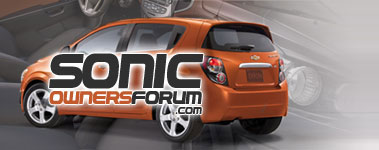JTee2017
Well-known member
What do you think .... .? Thoughts?
I was just looking through a Holden Barina (same as Sonic as most know) brochure and found an interesting item.
Under the engine listing it shows the standard 1.6L Non Turbo engine and it's specs. It also shows Recommended Petrol . .. . and "Alternative".
It lists ULP (Un-Leaded Petrol) or PULP (Premiun Un-Leaded Petrol) . .. for slightly higher performance.
Australian petrol has a somewhat different octane rating system than here in the U.S. The standard ULP is 91 RON and PULP is 95 RON. Now, this is where octane numbers need to be clarified. European (World) uses RON. . Research Octane Number and the U.S. uses MON or PON. . Motor Octane and Pump Octane Numbers respectively.
I've included a link to how this works out at the end of this post for those interested, but essentially, 91 ULP is 87 U.S. octane and 95 PULP is 91 U.S. octane.
The point is that according to the Holden Barina specs, its standard 1.6L non turbo engine can get "slightly better performance" using a 91 U.S. octane than the regular unleaded 87 U. S octane equivalent.
Included at the end of this post is info on comparing European (World) octane and U.S. octane numbers.
So it makes me wonder if the 1.8L non turbo engine in our U.S. Sonics might also benefit from using 91 octane fuel here? I've started using 89 and the next tank will be 91 or 93 octane in my 2017 Sonic HB with the 1.8L. I have to say, it does seem more responsive using even 89 octane. It seems at least noticeably quicker off the line at stop lights with a healthy press of the pedal to get and hold the engine between shifts at 3,000 to 3,500 RPM. I've found that this RPM range for the 1.8L is a sweet spot and where it comes more alive . . . thinking the variable intake manifold switches over at that point? (I just checked this. . Variable Intake takes over at 4,000 RPM, but peak torque is at and continues about 3,800 RPM.)
Anyway, I just thought that Holden recommends a premium fuel in its 1.6L non turbo engine for "slightly better performance".
Holden Barina (Sonic)
1.6 litre engine. Four cylinders. Double overhead camshafts operate four valves per cylinder.
Aluminium head. Multipoint fuel injection. Variable intake manifold. Adaptive knock control system
Bore x stroke (mm) 79 x 81.5
Capacity (cc) 1598
Compression ratio 1) 9.5
1) 9.5
Power (ECE)# 76kW @ 5800rpm
Torque (ECE)# 145Nm @ 3600rpm
Gear ratios Manual Auto
1st 3.54 2.87
2nd 1.95 1.57
3rd 1.28 1.00
4th 0.97 0.70
5th 0.76 –
Final drive ratio 3.94 3.84
Recommended petrol ULP (87 U.S. octane equivalent)
Alternative PULP for slightly higher performance (91 U.S. equivalent)
https://www.carsguide.com.au/holden/barina/price/2017
https://www.etuners.gr/fuel/
https://www.just-auto.com/analysis/analysis-holdens-future-under-gm-and-groupe-psa_id177300.aspx
I was just looking through a Holden Barina (same as Sonic as most know) brochure and found an interesting item.
Under the engine listing it shows the standard 1.6L Non Turbo engine and it's specs. It also shows Recommended Petrol . .. . and "Alternative".
It lists ULP (Un-Leaded Petrol) or PULP (Premiun Un-Leaded Petrol) . .. for slightly higher performance.
Australian petrol has a somewhat different octane rating system than here in the U.S. The standard ULP is 91 RON and PULP is 95 RON. Now, this is where octane numbers need to be clarified. European (World) uses RON. . Research Octane Number and the U.S. uses MON or PON. . Motor Octane and Pump Octane Numbers respectively.
I've included a link to how this works out at the end of this post for those interested, but essentially, 91 ULP is 87 U.S. octane and 95 PULP is 91 U.S. octane.
The point is that according to the Holden Barina specs, its standard 1.6L non turbo engine can get "slightly better performance" using a 91 U.S. octane than the regular unleaded 87 U. S octane equivalent.
Included at the end of this post is info on comparing European (World) octane and U.S. octane numbers.
So it makes me wonder if the 1.8L non turbo engine in our U.S. Sonics might also benefit from using 91 octane fuel here? I've started using 89 and the next tank will be 91 or 93 octane in my 2017 Sonic HB with the 1.8L. I have to say, it does seem more responsive using even 89 octane. It seems at least noticeably quicker off the line at stop lights with a healthy press of the pedal to get and hold the engine between shifts at 3,000 to 3,500 RPM. I've found that this RPM range for the 1.8L is a sweet spot and where it comes more alive . . . thinking the variable intake manifold switches over at that point? (I just checked this. . Variable Intake takes over at 4,000 RPM, but peak torque is at and continues about 3,800 RPM.)
Anyway, I just thought that Holden recommends a premium fuel in its 1.6L non turbo engine for "slightly better performance".
Holden Barina (Sonic)
1.6 litre engine. Four cylinders. Double overhead camshafts operate four valves per cylinder.
Aluminium head. Multipoint fuel injection. Variable intake manifold. Adaptive knock control system
Bore x stroke (mm) 79 x 81.5
Capacity (cc) 1598
Compression ratio
Power (ECE)# 76kW @ 5800rpm
Torque (ECE)# 145Nm @ 3600rpm
Gear ratios Manual Auto
1st 3.54 2.87
2nd 1.95 1.57
3rd 1.28 1.00
4th 0.97 0.70
5th 0.76 –
Final drive ratio 3.94 3.84
Recommended petrol ULP (87 U.S. octane equivalent)
Alternative PULP for slightly higher performance (91 U.S. equivalent)
https://www.carsguide.com.au/holden/barina/price/2017
https://www.etuners.gr/fuel/
https://www.just-auto.com/analysis/analysis-holdens-future-under-gm-and-groupe-psa_id177300.aspx
Last edited:

